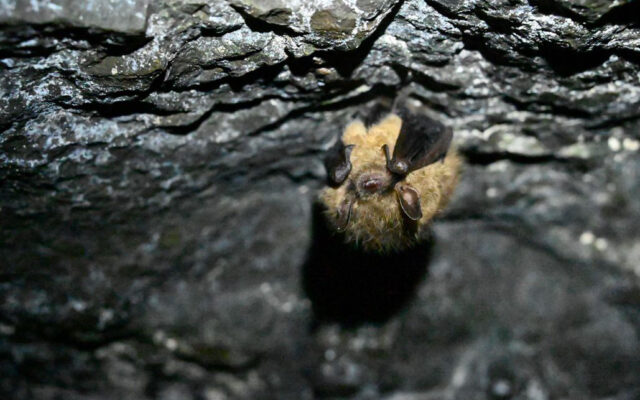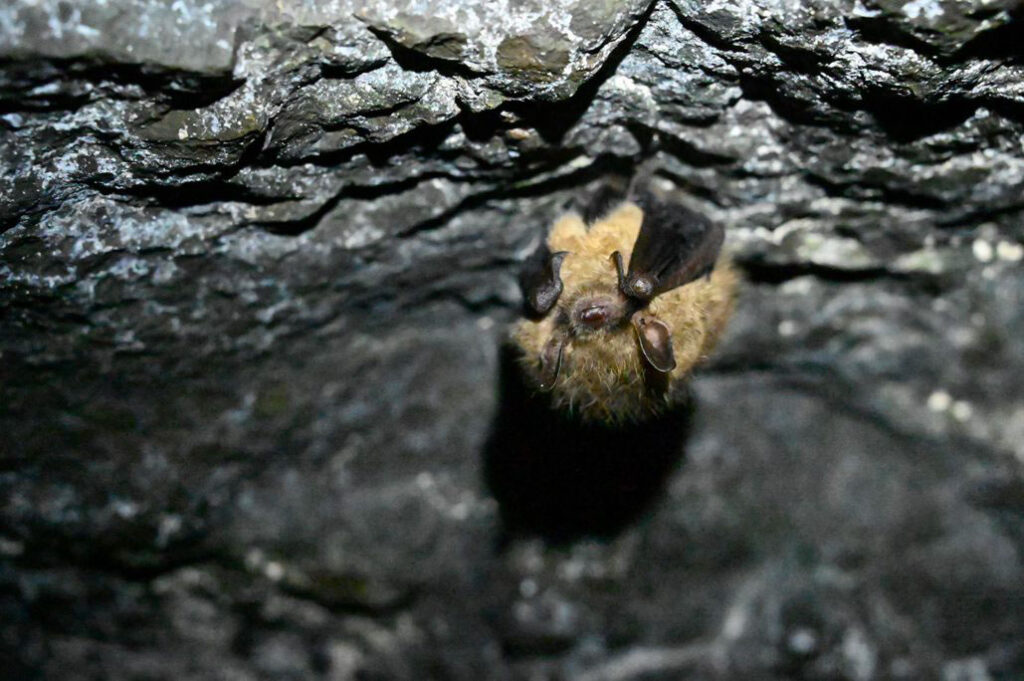
Endangered bats may be rebounding in Maine
By Kathleen Tomaselli, Houlton Pioneer Times Staff
An endangered species may be rebounding in the bat caves of Maine, state biologists said.
Following a catastrophic loss of the mammals statewide due to white nose syndrome, state biologists are more closely monitoring hibernating bat populations in caves and through acoustic recording.
It’s more difficult to determine bat numbers in Aroostook County because biologists haven’t found hibernation caves in the region, said Cory Stearns, small mammal biologist at the Maine Department of Inland Fisheries and Wildlife.
“It doesn’t mean there are no hibernation caves in Aroostook County, we just haven’t found any,” Stearns said.

LITTLE BROWN BAT — A Little Brown Bat is hibernating in a Maine Department of Inland Fisheries and Wildlife hibernacula (caves in which bats hibernate) this winter.
Nonetheless, early signs indicate that Maine’s endangered little brown bat population may be rebounding. This is good news considering another species, the northern long-eared bat, joined the federal endangered species list last fall and the tricolored bat has been proposed for the federal list.
Last month, state biologists surveyed three caves in Oxford and northern Piscataquis counties and found that little brown bats increased in the Piscataquis cave from two in 2020 to 21 this year, Stearns said.
Nineteen of those were little brown bats. Two were difficult to identify because of their positions in the cave, but they were likely little browns, he said.
Summer monitoring with acoustic recorders also suggests the little brown bat is starting to increase, Stearns said.
Maine’s eight bat species are on the species of special concern list and three are on the state endangered species list, including the little brown bat, the northern long-eared bat and the tricolored bat.
Only five of Maine’s bats — the little brown, large brown, hoary, silver-haired and eastern red — occur regularly in Aroostook County, Stearns said.
State biologists have never found the eastern small-footed bat as far north as Aroostook, possibly due to colder temperatures, Stearns said. The endangered northern long-eared bat and the tricolored bat are extremely rare in northern Maine and have been found in The County only a few times, he said.
First found in New York bats in 2006 and in Maine bats in 2011, white nose syndrome is a fungal pathogen that attacks bats hibernating in caves. It spread quickly, leading to a dramatic 95 percent drop in the state’s bat population. The little brown, northern long-eared, eastern small-footed and tricolored bats primarily are affected by the disease, Stearns said.
“We went from 300 to 400 bats among the three sites to the single digits in a couple years,” Stearns said.
Migratory species — hoary bat, silver-haired bat and eastern red bat — are not affected by the fungus, nor are large brown bats that live primarily in attics and barns, according to Stearns.
The fungus attacks the animal’s exposed nose skin, causing it to wake from hibernation more frequently to groom itself, depleting its fat reserves. They ultimately starve to death, he said.
April 24 marked International Bat Appreciation Day, started by Bat Conservation International as a way to bring attention to the tragic plight of bats and how important they are to the ecosystem.
A pregnant female can eat her whole body weight in insects on a near nightly basis, Stearns said.
According to the 2023 State of Bats Report, 52 percent of North American bats are threatened.
Fears about bats sucking a person’s blood or bats diving into heads and getting entangled in hair are myths. Bats are actually afraid of people who are potential predators.
“Bats certainly aren’t out seeking people to cause problems,” Stearns said.
Bat Conservation International encourages people to help bats by planting bat-friendly gardens with native species and reducing pesticides, adding bat water troughs and building bat boxes.
Little brown and large brown bats could eventually be drawn to a bat box in Aroostook County, Stearns said.
Bat houses should measure at least 24 inches high by 16 inches wide. In far northern regions like Aroostook County, the box should be painted black for warmth, according to Bat Conservation International. The boxes should never contain fabric or mesh, and roosting boards and landing pads should be roughened wood.
The houses should never be placed on trees, because predators, owls and hawks, wait on upper branches for bats to leave the roost, the group advised. The best location is under the eaves of a house in the direct sunlight.
A bat box also can be placed on a pole that is 10 feet or higher, Stearns said.
“People shouldn’t expect bats to move in immediately even if they are in the area,” he said, adding that they are loyal to existing roosts. “Once they find it, they are going to be there for years. But it could take a while to find it.”